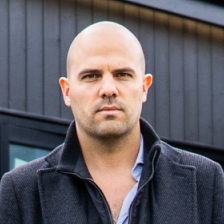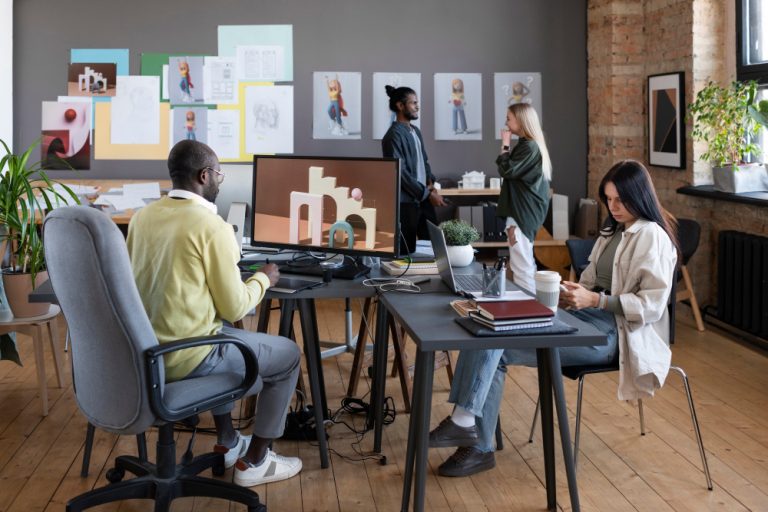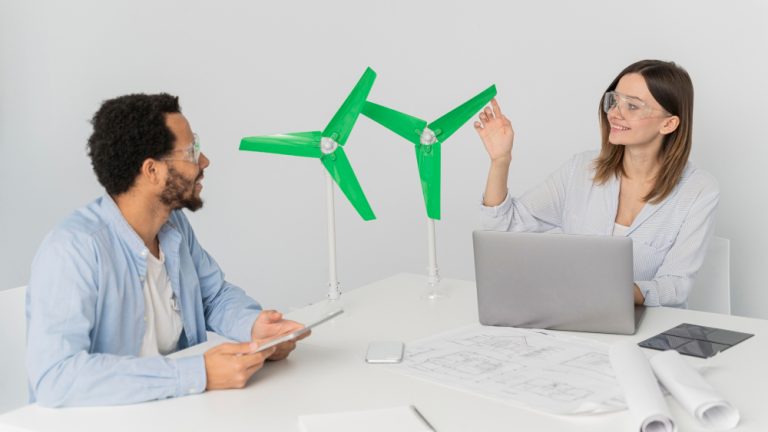Three months ago, I walked through a brand-new $12 million office space in Mountain View that was already failing.
Beautiful marble floors. Designer furniture. Floor-to-ceiling windows overlooking the bay.
And absolutely nobody wanted to work there.
The problem? They built a 2019 office in a 2025 world. While they were installing expensive conference rooms, their employees were demanding quiet focus pods. While they were creating impressive reception areas, their teams needed flexible collaboration zones.
After 15 years designing and building Silicon Valley workspaces, I’ve learned that stunning offices mean nothing if they don’t support how people actually work today. Here are the seven workplace design trends that are transforming Silicon Valley offices in 2025 – and why ignoring them could cost you your best talent.
1. Hybrid-First Workspace Design Is Now Non-Negotiable
The days of assigned desks and permanent offices are dead in Silicon Valley.
Every successful tech company I work with has embraced one reality: employees split their time between home and office. This isn’t a temporary pandemic response – it’s the new normal.
Smart companies are designing for flexibility from day one. Instead of 1:1 desk ratios, we’re building spaces that accommodate 60-70% capacity while providing premium experiences for those who come in.
Here’s what hybrid-first design looks like in practice:
- Hot-desking zones with premium technology: Every workspace needs multiple monitor setups, wireless charging, and seamless connectivity
- Neighborhood concepts: Different zones for different work styles – collaboration areas, focus zones, social spaces
- Booking systems integration: Spaces designed to work with reservation platforms so teams can find each other easily
- Storage solutions: Personal lockers and team storage since people can’t leave belongings at permanent desks
One client, a 150-person AI startup, redesigned their Palo Alto office using this approach. Employee satisfaction scores jumped 34%, and they’re now using their space 40% more efficiently. The result? They postponed expanding to a larger office, saving $2.3 million annually in rent.
The investment in flexible furniture and technology systems paid for itself in four months through space efficiency alone.
2. Wellness-Centric Design Drives Productivity and Retention
Silicon Valley’s war for talent has made employee wellness a competitive advantage, not a nice-to-have.
Companies that ignore this trend are losing their best people to competitors who understand that office environments directly impact mental and physical health.
The wellness features I’m building into every Silicon Valley office now include:
Biophilic Design Elements:
Living walls, natural materials, and abundant plants aren’t just Instagram-worthy – they reduce stress by 15% and boost creativity by 38% according to recent workplace studies.
Circadian Lighting Systems:
Smart lighting that mimics natural daylight patterns improves sleep quality and reduces eye strain. One client saw sick days drop by 23% after installation.
Air Quality Management:
Advanced filtration systems and real-time air quality monitoring. Post-pandemic, this isn’t optional – it’s expected.
Movement Integration:
Standing desk options, walking meeting paths, and micro-gym spaces. Sitting disease is real, and smart offices combat it proactively.
A cybersecurity company in Sunnyvale invested $180,000 in wellness-focused renovations last year. Their employee turnover dropped from 18% to 7%, saving them an estimated $1.2 million in recruiting and training costs.
When your average engineer costs $200,000+ to replace, wellness design becomes an obvious ROI play.
3. Acoustic Privacy Solves the Open Office Problem
Open offices aren’t going away, but smart companies are fixing their biggest flaw: noise.
I’ve watched millions of dollars in productivity vanish because brilliant engineers can’t concentrate in noisy environments. The solution isn’t going back to cubicles – it’s acoustic engineering.
Modern acoustic solutions I’m integrating into Silicon Valley offices:
- Sound masking systems: White noise technology that creates speech privacy without feeling oppressive
- Phone booth pods: Soundproof spaces for calls and focused work that can be added anywhere
- Acoustic panels as design elements: Sound absorption that looks intentional, not like an afterthought
- Material selection: Carpeting, ceiling treatments, and furniture chosen for sound dampening properties
The numbers speak for themselves. After installing comprehensive acoustic solutions in a 12,000-square-foot fintech office, we measured a 42% reduction in noise complaints and a 28% increase in self-reported productivity scores.
The cost? About $35 per square foot. The value of increased focus time for their 80-person engineering team? Immeasurable.
4. Technology Integration That Actually Works
Every Silicon Valley office claims to be “smart,” but most technology implementations are frustrating disasters.
I’ve seen companies spend hundreds of thousands on systems that employees ignore because they’re too complicated or unreliable. Smart technology should be invisible – it should just work.
Here’s what seamless tech integration looks like in 2025:
| Technology | Function | User Benefit |
|---|---|---|
| Occupancy Sensors | Real-time space availability | Find open meeting rooms instantly |
| Environmental Controls | Automatic climate adjustment | Perfect temperature without thinking |
| Wireless Presentation | Click-to-share from any device | No more HDMI cable hunting |
| Mobile App Integration | Control everything from phone | Book spaces, adjust settings, find colleagues |
The key is choosing systems that integrate with each other and require minimal training. If employees need more than 30 seconds to figure out how to use something, it will fail.
One SaaS company saw their meeting room utilization increase by 60% after we installed simple occupancy sensors and booking displays. No more wandering around looking for available rooms or interrupting meetings to ask if a space is free.
5. Flexible Collaboration Zones Replace Traditional Conference Rooms
Fixed conference rooms are inefficient relics in today’s dynamic work environment.
Traditional offices waste 40% of their meeting space because rooms are either too big, too small, or configured wrong for how teams actually collaborate. Modern Silicon Valley offices are embracing adaptability.
Instead of permanent conference rooms, we’re creating:
- Modular furniture systems: Spaces that can quickly reconfigure from presentation mode to workshop format
- Moveable walls: Partition systems that create privacy when needed, openness when desired
- Multiple collaboration styles: Standing height tables for quick check-ins, lounge areas for creative sessions, formal spaces for client meetings
- Technology that moves: Mobile presentation displays and power distribution that supports any configuration
A gaming company in San Mateo implemented this approach and increased their effective meeting capacity by 75% without adding square footage. Teams can now adapt spaces to their specific needs rather than forcing their work style into rigid room configurations.
The renovation cost $120,000, but they avoided a planned expansion that would have cost $800,000 annually in additional rent.
6. Sustainability as a Talent Attraction Tool
Silicon Valley’s workforce – especially younger employees – expects their workplace to reflect their environmental values.
This isn’t about corporate virtue signaling. Companies with strong sustainability programs report 25% lower turnover rates and attract higher-quality candidates who care about more than just compensation packages.
Sustainable design elements that matter to employees:
Energy-Efficient Systems:
LED lighting, smart HVAC, and renewable energy integration. These save money while demonstrating environmental commitment.
Sustainable Materials:
Reclaimed wood, recycled content flooring, and low-VOC finishes. Healthier for people and planet.
Waste Reduction Systems:
Comprehensive recycling, composting programs, and reusable resource libraries that employees actually use.
Water Conservation:
Smart irrigation for indoor plants, efficient fixtures, and rainwater collection systems where possible.
One clean tech startup achieved LEED Platinum certification during their office renovation. The process cost an additional $45,000 but helped them recruit three senior engineers who specifically mentioned the company’s environmental commitment during interviews.
Those hires brought expertise that led to a $3.2 million contract within six months. Sometimes doing the right thing is also the profitable thing.
7. Resimercial Design Creates Emotional Connection
The most successful Silicon Valley offices feel more like high-end homes than corporate environments.
“Resimercial” design – blending residential comfort with commercial functionality – addresses a fundamental problem: people spend more waking hours at work than at home, so why shouldn’t work feel welcoming?
Elements that create residential comfort in commercial spaces:
- Kitchen-style break areas: Real appliances, comfortable seating, and spaces that encourage informal interaction
- Living room aesthetics: Sofas, coffee tables, and warm lighting that make people want to linger and collaborate
- Hospitality-inspired amenities: Coffee bars, game areas, and quiet nooks that feel more like a boutique hotel than an office
- Personal touches: Art from local artists, plants throughout, and spaces for teams to display their personality
A data analytics company invested in resimercial design for their Palo Alto headquarters and saw employee satisfaction scores increase by 45%. More importantly, they’re now using their office as a recruiting tool – candidates consistently mention the environment as a factor in their decision to join.
The investment was $85 per square foot, but the ability to attract top talent in a competitive market made it invaluable.
Final Results
Workplace design in Silicon Valley isn’t about following trends – it’s about understanding how your team works and creating environments that amplify their success. The companies winning the talent war are those who invest thoughtfully in spaces that people actually want to use.
Here’s your action plan:
- Audit your current space: How well does it support hybrid work, wellness, and collaboration?
- Talk to your employees: What frustrates them about the current environment?
- Prioritize based on ROI: Start with changes that improve productivity and retention
- Plan for flexibility: Build in the ability to adapt as work styles continue evolving
Remember, your office isn’t just a place people work – it’s a tool for attracting talent, fostering collaboration, and driving business results. In Silicon Valley’s competitive market, companies with thoughtfully designed workspaces have a significant advantage.
Conclusion
The workplace design trends transforming Silicon Valley offices aren’t fads – they’re responses to fundamental changes in how we work. Companies that embrace hybrid flexibility, prioritize wellness, and create environments people love will thrive. Those that cling to outdated office concepts will struggle to compete for talent.
Your office design should be as innovative as your product. Ready to create a workspace that attracts top talent and drives productivity? Contact Greenberg Group for a free workspace design consultation tailored to your team’s unique needs and growth plans.




